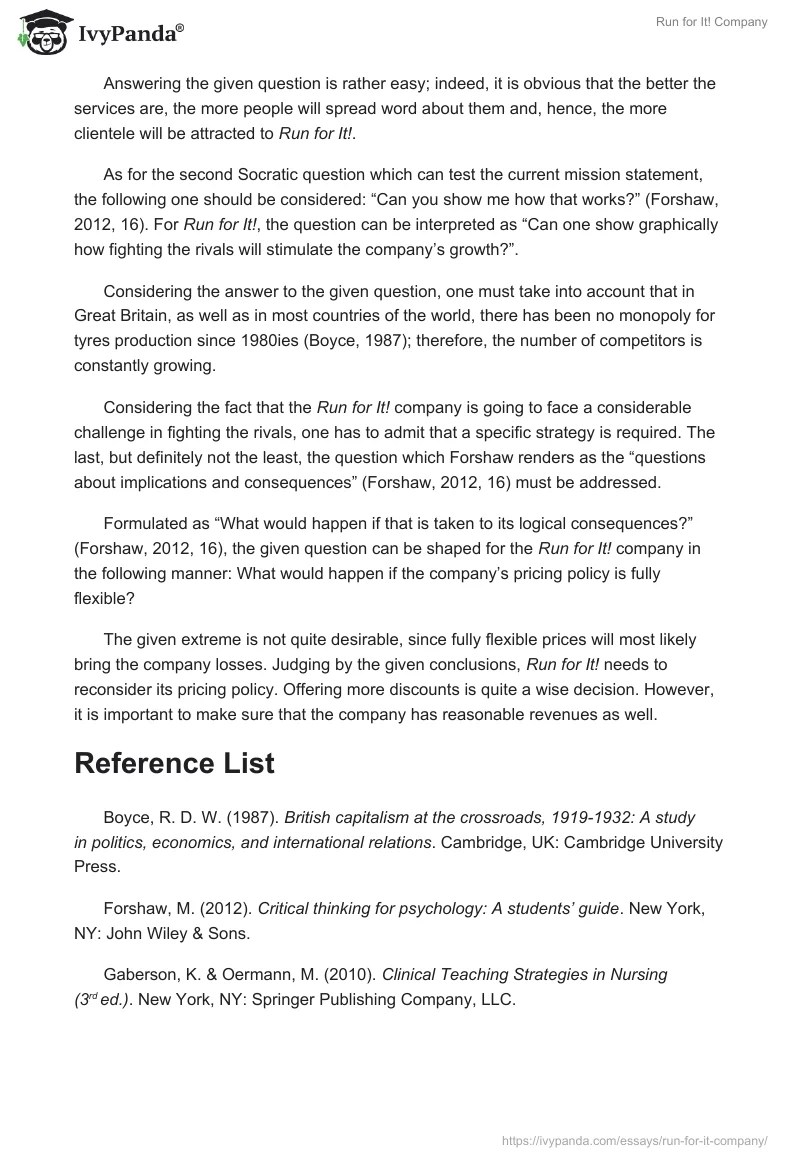No matter how hard people complain about cars, pollution, traffic and the related issues, it is impossible to imagine the world without all sorts of road transport. That is why, such companies as Run for It!, which sells tyres for cars, bicycles, trucks and other sorts of transport, will never be out of business.
Redefining the company’s mission and analyzing its current strategy, one can possibly define the strongest and weakest points of Run for It! And find out how to enhance the former and fight the latter.
To start with, the mission statement of the company, as one might have guessed already, is to provide the clientele with top-notch products and at the same time surpass the rivals in the quality of the product, offering flexible pricing policy.
However, it is essential to mention that Run for It! has not entered the world market yet and is currently trying to achieve success in its homeland, i.e., Great Britain.
Although Run for It! is not yet the member of The British Tyre Manufacturers’ Association, the company is trying to improve its current sales income to be able to enter the association.
Even though the above-mentioned mission statement sounds rather feasible, it is necessary to test its validity using several Socratic questions.
Unless the mission statement of the company contains the response to each of the chosen Socratic questions, it will be necessary to redefine the current mission statement, since “Socratic questions raise issues […] to consider, require analytical thinking to respond, and promote critical thinking” (Gaberson & Oermann, 2010, 245).
The first question which seems to be most suitable for assessing the company’s mission and goals is among the questions that probe assumptions.
According to the model offered by Forshaw, which looks like “Why are you assuming that X causes Y?” (Forshaw, 2012, 16), the given type of Socratic question applied to Run for It! will look in the following way: “Why is it assumed that providing better qualities will attract more clients to the company?”
Answering the given question is rather easy; indeed, it is obvious that the better the services are, the more people will spread word about them and, hence, the more clientele will be attracted to Run for It!.
As for the second Socratic question which can test the current mission statement, the following one should be considered: “Can you show me how that works?” (Forshaw, 2012, 16). For Run for It!, the question can be interpreted as “Can one show graphically how fighting the rivals will stimulate the company’s growth?”.
Considering the answer to the given question, one must take into account that in Great Britain, as well as in most countries of the world, there has been no monopoly for tyres production since 1980ies (Boyce, 1987); therefore, the number of competitors is constantly growing.
Considering the fact that the Run for It! company is going to face a considerable challenge in fighting the rivals, one has to admit that a specific strategy is required. The last, but definitely not the least, the question which Forshaw renders as the “questions about implications and consequences” (Forshaw, 2012, 16) must be addressed.
Formulated as “What would happen if that is taken to its logical consequences?” (Forshaw, 2012, 16), the given question can be shaped for the Run for It! company in the following manner: What would happen if the company’s pricing policy is fully flexible?
The given extreme is not quite desirable, since fully flexible prices will most likely bring the company losses. Judging by the given conclusions, Run for It! needs to reconsider its pricing policy. Offering more discounts is quite a wise decision. However, it is important to make sure that the company has reasonable revenues as well.
Reference List
Boyce, R. D. W. (1987). British capitalism at the crossroads, 1919-1932: A study in politics, economics, and international relations. Cambridge, UK: Cambridge University Press.
Forshaw, M. (2012). Critical thinking for psychology: A students’ guide. New York, NY: John Wiley & Sons.
Gaberson, K. & Oermann, M. (2010). Clinical Teaching Strategies in Nursing (3rd ed.). New York, NY: Springer Publishing Company, LLC.

 4.50
4.50
